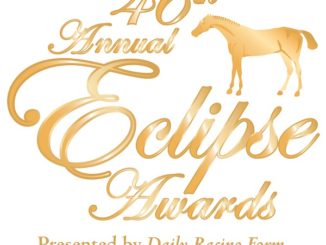
Several days removed from the announcement of 2016 Eclipse Award finalists, there is still chatter and debate going on over social media in regards to Lady Aurelia’s qualifications for the two-year-old filly award.
Some voters, whose opinions on various matters I generally respect, have defended her position as a finalist, but I feel that view is greatly misguided and sets a bad precedent (and there have already been too many of those over the past 20 years). And I say this with all due respect to them, the filly and her connections.
What follows is a Q&A that may help explain how some of us feel about the situation.
Q: Is Lady Aurelia eligible or not for the Eclipse Award?
A: Technically, yes. The voting instructions say that in equine categories, “individuals are limited to voting only for Thoroughbreds who have raced at least one time in 2016 in the United States or Canada.” She qualifies on the basis of her winning debut in a maiden race at Keeneland on April 21.
However, she does not qualify in the sense that the award was created to honor excellence for performance in North America. She never competed in a stakes, graded or otherwise, on North American soil during 2016, and no horse has ever earned an Eclipse Award (nor should they) based solely on performance in overnight races (i.e. maiden, allowance, claiming) if that is their only source of eligibility.
Q: Should the fact she was trained in the U.S. prior to her stakes victories abroad make any difference?
A: No.
Q: What’s the difference between what Lady Aurelia did and all the European-based horses of the past who won an Eclipse Award off one start in North America?
A: Well, they actually won a stakes race on the continent. She did not.
Q: What about Trillion?
A: Trillion was the inaugural champion turf female in 1979. She did not win a stakes in North America, but finished second to males (including to fellow grass champion Bowl Game twice) in the Canadian International (G1), Turf Classic (G1), Oak Tree Invitational (G1), and Washington, D.C. International (G1). Her average margin of defeat was three-quarters of a length.
The fact she did all that in the span of three weeks is obviously impressive by current standards. I wasn’t around then and wouldn’t know who her competition for the award was without researching it, but suffice it to say voters then were navigating uncharted territory with respect to a category that was brand new and with far fewer graded turf stakes restricted to fillies and mares to consider. It’s also worth noting the electorate has never gone out of its way to repeat this by giving an award to a horse that failed to win a stakes in North America.
Q: What about Singspiel?
A: In 1997, Singspiel won turf male honors despite not having run in the U.S. at all. In two races on the North American continent, he won the Canadian International and finished second in the Breeders’ Cup Turf (G1), a race that originated in the U.S. which happened to be run at Woodbine that year. Boston Harbor, Storm Song, Lit de Justice, and Jewel Princess also won Breeders’ Cup races at Woodbine that year to clinch their respective division titles.
Beginning in 1998, the responsibility of grading Canadian stakes came under the purview of Canadian authorities rather than a U.S.-based committee. Considering that, and the fact Canada honors its own champions via the Sovereign Awards, perhaps performance north of the border should not necessarily carry equal weight with U.S. form in terms of Eclipse Award eligibility as was the case years ago. That’s an argument for another time.
Q: Has there ever been a North American-based divisional champion that clinched their title with a win outside the continent?
A: None that I’m aware of, though grass champs Kotashaan (1993) and Paradise Creek (1994) turned in credible efforts in the Japan Cup (G1). But their performances in the U.S. alone were enough to make them worthy choices.
Q: So if Lady Aurelia shouldn’t be eligible for her division title based on foreign success, why all the fuss about Tepin’s wins in the Queen Anne (G1) at Royal Ascot and the Woodbine Mile (G1)? Why should those “count”?
A: Whether those “count” or not is up to the individual voter. For me personally, foreign success can potentially enhance but not hurt a horse’s chances at winning an Eclipse Award. But that horse should still have some modicum of success against graded stakes company in North America and be eligible in that regard. Tepin qualifies on that count with four graded stakes wins in the U.S. and a solid second against males in the Breeders’ Cup Mile (G1). That’s an apples and oranges comparison with Lady Aurelia.
Q: Don’t you think Eclipse voters of the past, when selecting a European-based horse for a division title, considered their foreign form as well? It would be naive to think otherwise.
A: It’s not something I have ever done nor would ever do, but perhaps others have. But again they wouldn’t have considered these horses at all if not for their success in North America. And let’s face it, the foreign form of April Run (1982), Miss Alleged (1991), Hatoof (1994), and Cape Blanco (2011), to name a few, was hardly compelling stuff much less worthy of honoring with a divisional championship. When the dust settles, it’s what happens here that should count most.
Q: Let’s go back to Lady Aurelia vs. Tepin. What’s your arbitrary cutoff as far as number of starts in North America required for a divisional champion?
A: I would hardly call it arbitrary, but I’m fine with the general precedent established in the Breeders’ Cup era that at least one graded stakes win in North America is good enough for a division title. Obviously a bit more if you’re talking Horse of the Year.
Q: Would we be having this discussion if we had had another Songbird-like filly in the division this year?
A: Of course not, and it’s unfair to expect a filly of that quality to emerge on an annual basis. Frankly, the form of Champagne Room, for example, is no better or worse than, say, She’s a Tiger (2013), Caressing (2000), or Epitome (1987). Just because nominal champions like these pop up from time to time doesn’t mean we have to throw the baby out with the bathwater.




Why do you think that the Eclipse committee has for so long resisted modifying/expanding and clarifying its “rules”? The discussion comes up every year when various attempts are made by many to “refine” the criteria for a horse’s consideration in a category.
I think there was a change to distinguish “dirt” older horse from “turf” horse, recently. It seems the Committee has taken great pains to impose as few criteria as possible.